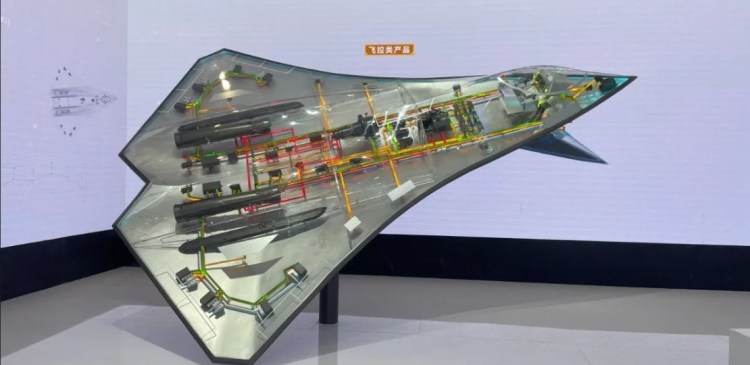The following article first appeared on Warrior Maven, a Military Content Group website.
(Washington D.C.) A stealthy, supersonic, semi-autonomous 6th-gen fighter maneuvers undetected through heavily armed enemy air space, evades radar detection to …. jam the adversaries command and control systems with EW weapons, gather, analyze and transmit targeting data across huge areas of terrain in milliseconds using AI-empowered computing, launch and operate groups of nearby minidrones, fire air-launched hypersonic missiles and then… incinerate enemy aircraft with fighter-jet fired precision laser weapons … all while flying too quickly at hypersonic speed and too stealthily to be targeted.
Taking this hypothetical mission yet another step farther, what if the 6th-Gen fighter not only performed many of its missions with complete autonomy but also operated with a kind of self-regenerating coating or even composite armor which used synthetic biology to essentially regenerate and restore external structures lost or damaged by enemy fire?
In 2030, all this could be reality, should various breakthrough innovations come to fruition and continued research, testing and integration keep hitting new levels.
The alignment and collective execution of these now-in-development technical attributes rests almost entirely on the continued pace of Pentagon and industry innovation now striving to prepare for and anticipate the unknown, if not even somewhat mysterious, future warfare environment. Making these things happen, and integrating them to one another such that they complement one another in a coordinated fashion, requires visionary thinking, some amount of guessing and a delicate blending of art and science combining the best conceptual theorizing with early evidence of scientific promise. Generally speaking, these are the kinds of innovations now being explored by the Pentagon, senior weapons developers and some of its key industry partners such as Lockheed Martin’s Skunk Works and Raytheon’s Advanced Concepts & Technology division.
Do We Need 6th-Gen
The F-35 brings stealth, paradigm-changing sensors, and a new generation of AI-enabled computing and the F-22 brings unparalleled thrust-to-weight ratio, speed, and air-to-air combat superiority.
Both platforms are positioned such that they can be upgraded and improved decisively in the coming years as computing, sensing, and targeting technologies emerge.
Both the F-35 and F-22 have already been enhanced to paradigm-changing levels through software upgrades that enhance drone controls, weapons delivery, sensing range, fidelity, and on-board computing.
Making Room for the Next Generation Fighter
These circumstances might lead someone to wonder why or how a 6th-generation aircraft could improve upon this. Essentially, is one truly necessary, given the proven extent to which the F-35 and F-22 can be upgraded?
Most anticipated future innovations are likely to take place in the realm of sensing, computing, targeting, networking, and command and control, meaning an aircraft can surge into future capabilities without there being a need to construct an entirely new airframe. This may be one reason why the Air Force is currently re-evaluating its plans for a 6th-gen platform.
New coating materials might enhance stealth properties, but is there really a need to engineer a new fuselage or external configuration if the existing 5th-gen fleet can be upgraded with great effect in the coming decades?
Why We Need 6th Gen
Whether there is a need for a new generation of aircraft is indeed an interesting and pressing question, as some might wonder if technology has progressed to the point where it becomes advantageous and sensible to engineer an entirely new 6th-generation platform.
Would it be more expedient, affordable, and beneficial to the Pentagon’s long-term air war capability to simply keep upgrading the 5th-generation fleet?
While some may think upgrading the current generation fighters is ideal, and is likely an entire sphere of unknown variables of relevance to this, yet there may indeed be sufficient reason to architect a new airframe.
If available images or “renderings” of 6th-generation stealth fighter jets are any indication, the actual 6th-generation prototype demonstrator may be built with an entirely new generation of stealth technologies.
That would appear to be the case, if the largely secret, yet airborne 6th-generation fighter jet, was similar in configuration to images offered by Lockheed, Northrop Grumman, and Boeing. All of the 6th-generation images presented by industry competitors showed an entirely different airframe configuration without fins, tails, or vertical structures.
This would suggest, should it be similar to the actual configuration of the existing 6th-generation plane, that perhaps there is a new generation of stealth technology that can lower a fighter’s radar signature while still ensuring maneuverability.
Specifics related to such a breakthrough, should a new airframe already exist, are likely not available for understandable security reasons, yet it is entirely conceivable that some of the stealthy, tailless designs offered by the industry are delivering a new generation of stealth technology without compromising speed and aerial agility.
6th-Gen is Here — How is it Better?
The Navy and Air Force variants of a 6th-generation Next-Generation Air Dominance (NGAD) stealth fighter are rapidly coming to life, and not a moment too soon as the current threat environment is such that a faster, stealthier, and far more lethal fighter jet could soon be deemed critical.
It is important to recognize that, through ongoing software upgrades, the F-35 may well remain dominant into the 2070s and beyond, as many of the most substantial technological leaps forward will likely be in the areas of computing, AI, mission systems, weapons, and command and control. These areas can be modernized in paradigm-changing ways without having to reconfigure the main fuselage or fundamental architecture of the plane itself.
There are far too many of those most needed attributes for a 6th-generation fighter to cite, however, AI-enabled targeting data analysis, sensor range, and fidelity will need to be paradigm-changing. A breakthrough high-speed, ultra stealthy 6th-generation aircraft will massively achieve overmatch if it has an F-35-like long-range and high fidelity targeting sensors to see and destroy enemy targets from standoff ranges before it is seen itself. An ability to network with ground command centers, drones, other fighter jets, ground vehicles, Navy ships, and even satellites will enable the platform to gather and process time-sensitive data needed to move in and attack and destroy an enemy.
While speed and maneuverability will of course be critical, long-range sensors, networking, high-speed, AI-enabled computing, and weapons guidance will likely be what separates the 6th-generation fighter from competitors.
The urgent need for a 6th-generation aircraft like NGAD is largely driven by the current threat circumstances, which include the emergence of the Chinese J-20 and J-31 and Russian Su-57. While there is no clear indication that these platforms are in fact superior to a U.S. Air Force F-22 and F-35, their existence certainly drives an additional need to stay in front of great power rivals. China and Russia already suffer from a significant numbers deficit when it comes to 5th-generation aircraft, yet the attributes and specific performance parameters of Russian and Chinese may be somewhat of a mystery. All the more reason why breakthrough or “disruptive” technologies need to be leveraged.
China’s 6th-Generation Stealth Fighter Design and Technology – US “Copycats”
The largely secret US 6th-Generation aircraft is already airborne, and its design has not yet been visible to the public, likely for security reasons. Preliminary design renderings offered by several US industry jet-manufacturers hoping to compete for the US 6th-generation stealth fighter program show similar “tailless” flat, blended wing-body designs with no fins or vertical structures. Designs offered by both Lockheed and Northrop Grumman several years ago show a smooth, stealthy 6th-generation plane without tails or fins.
Although the actual prototype or demonstrator design of the US 6th-gen fighter, called Next-Generation Air Dominance, is not known or publicly available, the Chinese design looks strikingly similar to those offered several years ago by US weapons manufacturers.
The Chinese state-backed Global Times newspaper cites a video in which the 6th-generation design appeared by the state-backed. Aviation Industry Corporation of China.
The paper goes on to describe the tailless, finless aircraft design as a “blended wing-body design” able to provide “higher lift, longer range and lower fuel consumption,” yet the largest advantage associated with the design is likely in its stealth capabilities. Vertical structures such as tails and fins do of course greatly help increase speed, maneuverability and an ability to vector, all with intent to reduce any radar return signature available to enemy air defenses.
Chinese rendering of a 6th-gen aircraft.
At the same time, protruding or vertical structures such as fins or tails, as well as contours of weapons hanging from external pylons or weapons pods, offer more shapes and structures detectable to electromagnetic pings from enemy radar which are then able to send a return signal or rendering by “bouncing” off of the shapes. Sharp edges and tails, for example, are more detectable to enemy radar than an entirely smooth aircraft, such as the B-2, would be. This is why stealth fighters such as the F-35 fly with an internal weapons pod to create a “smooth” exterior without weapons pylons likely to generate a return radar signature to enemy air defenses.
‘The Chinese paper cites some of the engineering challenges associated with “thrust-vectoring” when it comes to an aircraft not having vertical tails.
“Without vertical tails, the new aircraft will lose out on maneuverability if it does not use other designs or technologies to compensate, like thrust vectoring control-capable engines and split brake rudders, or other innovative approaches,” the Chinese paper quotes military analysts stating.
Regardless of its stealth properties and aerodynamic design of the emerging Chinese aircraft, it does appear to be somewhat of a “copycat” of US renderings from several years ago. This would of course not be surprising to many, as there is a well-documented, public concern about the arguably “transparent” Chinese effort to rip-off, copy or use cyberespionage to simply “steal” US weapons specs.
Therefore, also not surprisingly, a description of technical plans and systems applications being engineered into China’s 6th-generation technology offered by the Global Times as far back as several years ago in 2020 appears to mirror that which is often described about the F-35. In 2020, the Chinese newspaper in 2020 says the emerging PLA Air Force 6th-gen aircraft will have an autonomous computerized ability to gather, organize and present an array of otherwise disparate pools of information for pilots.
Quoting J-20 designer Yang Wei, the 2020 Global Times article states, “a future fighter jet will generally require a longer combat range, longer endurance, stronger stealth capability, a larger load of air-to-air and air-to-surface weapons, and the functionality to provide its pilot with easy-to-understand battlefield situation images and predictions.”
The emphasis of technologies engineered to provide pilots with “easy to understand” warzone intelligence aligns almost exactly with the often-discussed F-35 “sensor fusion.” In an F-35, data from 360-degree cameras, long-range electro-optical targeting, navigational details, threat warning systems and other variables such as speed, altitude and angle of approach, are all compiled, distilled, analyzed, integrated and presented to pilots on a single screen.
This kind of technical phenomenon is closely paralleled by the Chinese vision for its new generation fighter. For instance, the paper describes how, “in an integrated system, the aircraft should be able to form a network, draw real-time integrated situational images, create multiple attack routes, and transmit target information across mission areas in real time.”
At the same time, Artificial Intelligence (AI) is figuring prominently when it comes to early conceptual work and prototyping pertinent to U.S. sixth-generation stealth fighter work. Perhaps even more data, including electronic warfare, space, radar warning receivers, cyber and as-of-yet- unknown types of indicators will increasingly be incorporated into onboard AI systems. Advanced algorithms can quickly perform analytics upon a vast array of incoming information, bounce it off a seemingly limitless database and make near real-time decisions, computations and analyses. Improving the speed of decision-making and providing clarity for pilots are often referred to as “easing the cognitive burden.” These are the fundamental tenets of AI-empowered programs, therefore explaining the sought-after emphasis for a new generation of Chinese stealth fighters.
Referencing the famous, U.S.-created OODA Loop concept (observation, orientation, decision, action), the Chinese paper refers to its next-generation fighter as developing “OODA Loop 3.0.” The OODA Loop refers to how quickly a warfighter or unit can make a decision. The idea is you will lose the advantage and initiative if the enemy’s OODA Loop and decisions/reactions are faster than yours. Of course, China would love to have superior OODA Loop for its upcoming stealth fighter compared to America’s F-22 or F-35.
Conformal sensors woven into an aircraft fuselage, often called “smart skins,” are some of the kinds of technologies thought of as examples of newer applications likely to inform sixth-generation fighter construction. Additional or new stealth configurations, advanced weapons such as lasers, adaptive engines and the “ability to command drones,” are all attributes cited in the Chinese report.
While much has been discussed regarding the stealthy exterior of China’s fifth-generation aircraft with respect to it appearing as a transparent or deliberate F-35 rip-off, less has been known about the internal technical specifics of advanced Chinese fighters. The true margin of difference, when it comes to what may or may not make a fifth or sixth generation aircraft superior to another, may likely reside in the area of AI and its impact upon computing, sensing, targeting, maneuvering and various kinds of attack tactics.
The F-35 Can Fly Alongside NGAD
In short, the F-35 seems to have the potential to stay in front of threats for decades. However, this does not mean there is not an urgent need for a U.S. Navy and Air Force 6th-generation fighter for several key reasons. The F-35 is a multirole fighter with speed, maneuverability, breakthrough computing, and a drone-like 360-degree surveillance capability. Attributes that make it an ideal “partner” or supplement to an ultra high-speed, ultra-stealthy 6th-gen stealth fighter.
A sixth-generation craft will be more of an F-22 replacement in terms of air supremacy and speed, yet many of its breakthroughs will come in the realm of “manned-unmanned” teaming and command and control. New datalinks, command and control technology, and AI-enabled data analysis will enable a 6th-generation “family of systems” wherein a single manned platform simultaneously operates five or six drones.
The concept for a 6th-generation fighter or NGAD, as explained by Air Force Secretary Frank Kendall, is described as one of the services’ key “operational imperatives” wherein a family of systems will perform a wide range of missions.
Navy’s F/A-XX
Of course planning and technological specifics related to F/A-XX are likely not available for security reasons, yet conceptual work on the fighter has been under way for many years. The requests spreads the billions out over the next five years, yet an essay in The Drive pointed out that this may be an indication that prototypes or demonstrators are on the near horizon.
This would not be surprising given the large extent to which the Air Force, for example, has successfully accelerated weapons platform design, development and production through the use of digital engineering. Advanced computer simulations can now precisely replicate key weapons performance parameters, a circumstance which enables weapons developers and innovators to analyze a number of different designs and performance specs of a given weapons system much more quickly and efficiently.
Along with the Air Force 6th-gen aircraft, the service’s new ICBM called the Sentinel also emerged ahead of schedule due in large measure to the successful application of digital engineering. Senior Air Force weapons developers, for example, say digital simulations enabled engineers and analysts to assess eight or nine different ICBM models before deciding which ones to build. This proved critical as the Air Force did not need to build ten different prototypes and “bend metal” as much to determine the optimal designs with the new ICBM, a scenario which may pertain to 6th-generation as well.
Therefore, given the success thus far with the use of digital engineering across several large weapons platforms, it seems entirely feasible that such progress at least in part accounts for Navy progress and funding increases with its F/A-XX aircraft. Perhaps demonstrators will take to the sky if they have not already. Designed to fly alongside and ultimately replace the F/A-18 Super Hornet, the F/A-XX is expected to break new ground in the realm of carrier launched stealth aircraft.
Certainly many of the specific technologies are likely not available, yet industry and Pentagon weapon developers have in recent years explained a series of potential requirements, concepts of operation and technologies likely to inform Navy 6th-gen development. Some of the key areas which come to mind include the use of multiple drones, drone swarms or other unmanned systems, AI-enabled networking, new generations of sensing and targeting and an ability to share real-time combat data with existing 4th-generation aircraft.
The Pentagon, Navy and Air Force, for example are all fast advancing technology enabling manned stealth fighters to control multiple drones from the cockpit, to leverage speed of attack and enable survivable forward reconnaissance. A carrier-launched 6th-gen could, for instance, direct multiple drones from the cockpit to test enemy air defenses, blanket an area with surveillance or even launch attacks when directed by a human.
The aircraft will likely incorporate new paradigms of stealth technology as well, wherein heat signatures and radar return signals can more easily be greatly minimized, if not eluded completely.
NGAD & F/A-XX to Feature EW
Several years ago, former Chief of Naval Operations Adm. Jonathan Greenert said whoever dominates the electromagnetic spectrum will likely prevail in war.
The Navy’s 2024 budget documents reveal this emphasis as they allocate large amounts of money to “spectral” dominance regarding the 6th-Gen F/A-XX stealth fighter jet. Lasers, EW weapons and RF countermeasures are all technologies expected to figure prominently with NGAD, Navy and Air Force budget documents explain. The Air Force’s Fiscal Year 2024 budget request calls for “studies…… to develop operational/system architectures to include family [sic] of systems and spectral dominance platforms.”
Jamming weapons guidance systems, “blinding” an enemies’ targeting sensors, disabling communications systems and interfering with radar systems are all critical future warfare missions potentially performed by electronic warfare systems.
Dominating the electromagnetic spectrum is fast becoming a heavily prioritized area of future warfare focus given the growing extent to which networks and weapons systems rely upon electronics. A precision-guided weapon, for example, cannot hit its target if its RF guidance is interfered with or jammed by an EW.
There are growing applications for EW due to rapid technological advances. AI-enabled, software-driven systems, for instance, can help deconflict the spectrum by identifying friendly from enemy frequencies and identifying which signals to jam. Spectrum information can be bounced off of a database to make rapid identification of which signals to jam.
Also, sensors and communications systems can be tailored to emit a more “narrow” or streamlined “pencil” beam type of electromagnetic signal. This is extremely critical as a larger or broader electronic signature can give away a location to an enemy, whereas a more targeted beam can exact an effect without emitting a large signature. When it comes to weapons guidance systems, developers are working on a technology called “frequency hopping” to essentially “counter” an electromagnetic jamming effort.
Should one frequency be “jammed” or interfered with, weapons guidance systems can be adjusted to essentially “hop” from one frequency to another in order to sustain its track or guidance to a target. Hardening networks, datalinks or communication systems to operate in a jamming environment is critical to sustaining functionality in a contested EW environment.
For 6th-generation aircraft, EW can prove critical in the realm of manned-unmanned teaming, as both the Navy and Air Force plan to operate a “family of systems” wherein manned fighter jets control nearby drones from the cockpit. This can enable forward operating drones to “jam” enemy air defenses, overwhelm communications and share critical targeting detail across formations.
Passive EW can essentially “listen” to identify a “line of bearing” on an enemy electronic communication to locate signals to monitor or jam, whereas active EW can emit a signature to block, jam or interfere with a communication.
Platforms are also increasingly using omni-directional antennas to tailor an electronic signal in a specific direction and avoid emitting a large 360-degree signature which would be easier for an enemy to detect. For example, 6th-generation aircraft and the drones they network with can use hardened data links or sigint assets to emit EW signals for offensive use and also “harden” datalinks for more secure information exchange in a contested environment.
These kinds of applications are critical to Navy and Air Force plans for 6th-generation manned-unmanned teaming, referred to as Combat Collaborative Aircraft, or CCA. The concept is to network a “family” of systems to one another in real time using drones in close coordination with manned-fighter platforms to conduct forward surveillance, test enemy defenses, ensure precision guidance, harden targeting sensors or even deliver weapons.
Will AI-Robot Pilots Fly 6th-Gen
Breakthroughs in autonomous navigation have developed in recent years, and the ability of drones and unmanned systems to increasingly perform a growing range of functions without needing human intervention is expanding.
This is well-known and documented, yet the technological progress raises the somewhat pressing and easily overlooked question of whether a manned NGAD 6th-generation fighter is actually necessary.
NGAD: Manned and Unmanned
Can unmanned systems, empowered by AI-generated computing, algorithms enabling autonomous targeting, maneuvering and flight path adjustments, and breakthrough kinds of data analysis, outperform any manned platforms?
The answer may, at least in some respects, be a clear yes, yet does that mean human consciousness and decision-making abilities are or will become obsolete and worthy of being replaced by AI-enabled algorithms?
After all, information itself, particularly when it comes to networking an attacking force to expedite sensor-to-shooter time and quicken the “kill web,” is increasingly viewed as a defining weapon of war. This premise, which relies often upon an AI-empowered ability to gather, analyze, organize and share time-sensitive data, forms the conceptual backbone of the Pentagon’s emerging Joint All Domain Command Command and Control program. Why can’t drones simply perform the entire range of missions intended for the Air Force’s and Navy’s 6th-generation manned platform? After all, the Air Force has already successfully flown unmanned fighter jets and even manned jets with an AI-enabled computerized co-pilot.
Manned-Unmanned Teaming
The reason there will still be a need for a manned platform, despite the rapid progress of AI-enabled computing, decision-making, and autonomy, is that there are attributes unique to human cognition that computers are simply not able to replicate. Certainly, AI-enabled high-speed computing can perform limitless amounts of procedural functions, analysis, and determinations without needing human intervention.
This is not only true at the moment but becoming increasingly true as technology continues to advance. However, there are specific elements of human cognition and dynamic decision-making, such as emotion, intuition, and other more subjective phenomena that computers simply cannot emulate.
Therefore, human decision-making will remain critical for the foreseeable future. It is one reason why the prevailing consensus among weapons developers is that the optimal approach needs to involve a combination of both human decision-making faculties and AI-empowered computer analysis. Both are needed, and the combination of the two is seen as the optimal approach to crafting future warfare tactics.
There is also an aerial command and control element, meaning there will be a need for a manned aircraft to function in a critical, time-sensitive command and control capacity from the air. The Air Force is already building what it calls Collaborative Combat Aircraft, or CCAs, essentially drones to fly in support of a manned NGAD 6th-generation fighter operating in a command and control capacity.
Technology is now enabling manned fighter jets to control groups of drones from the cockpit, a scenario that reduces latency and increases operational flexibility.
Operating as a “family of systems,” the CCAs will support a manned NGAD 6th-gen fighter to conduct forward surveillance, test enemy air defenses, network with ground forces, and even deliver weapons strikes when directed by a human.



